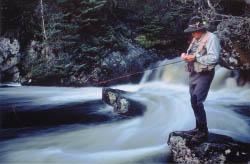The Absolute Beginner
The Art of Being Sneaky

By Piscator
There are two basic components to streamcraft:
While the first applies equally when targeting any
species, the last varies dramatically between species.
Some species, such as trout (brown trout particularly),
tend to be more skittish than others. Therefore, we'll
focus on streamcraft for resident trout.
Because approaching trout without disturbing them is
much easier to teach and to learn than locating the,
we'll deal with this first.
We'll also focus mainly on tactics for streams rather
than big rivers, for, although most of the basic principles
apply whatever the size of the water, sneakiness is much
more important on streams, where it's usually a major
advantage to get as close to the fish as possible.
Making the Approach
This amounts to little more than basic common sense and
controlling the natural urge to rush up to the water and
start flailing away. It's a matter of seeing without
being seen, heard or felt.
First of all, dress appropriately: go drab. Resist those
bright designer clothes and shiny embellishments on your
gear and accessories. Wear muted greens, blues and earth
colors - anything which blends with the natural colours
of the stream bank and vegetation.

Approach the stream carefully, staying back and taking
a good look so that you can plan ahead where you intend
to make your first cast from. Count to ten, then slowly
work yourself into position. Keep as low a profile as
you can, crouching - crawling, even. Whatever you do,
don't break the trout's horizon behind you with your
silhouette. Use all the cover you can, especially
bankside vegetation. You don't have to actually hide
behind the bushes and trees: it's just as effective
to huddle up in front of them. It's equally important
to tread softly. Trout have a very sensitive organ called
lateral line which picks up vibrations transferred though
the bank and into the water. If you tread heavily or stumble,
they'll feel it and be instantly aware of danger. Don't
worry about talking or even shouting, as trout are much
less able to detect sound. Because trout are particularly
sensitive to vibrations in the water, try to avoid wading
as much as possible - especially in very small streams.
should also avoid sudden movement. Even if you're well
camouflaged, trout with detect these.
Presenting the Fly
The idea is to get as close to the fish without being detected,
so that you can present your fly with the shortest possible
cast. Not only does this allow you to present the fly more
accurately; it also enables greater control, as you'll have
less line on the water. An approach from downstream of the
rising fish or holding lie allows the closest approach, as
trout always hold their heads into the flow. By crawling
and kneeling to cast (often in the water at the edge of the
stream), you'll find that you can usually approach to within
less than 20 feet of the target. If you're casting across
and swinging a wet fly or a streamer downstream, you won't
be to approach as closely. In these situations it helps
if you can find a strategically placed bush to lurk behind
if the stream is running through open terrain. On streams
with tall trees along the banks, you can usually work your
way down a run or riffle by wading right at the edge of the
stream with your back tight against the trees. You'll have
to use a roll cast here, as there won't be enough room for
a backcast. You should also wade very carefully, moving
just one foot at a time slowly, and try not to lift your
foot out of the water, rather slide it gradually forward
beneath the surface. This creates far less vibration than
bringing it back into the water with a splash.
It doesn't matter how well you can cast or how effectively
you can match the hatch and present your fly, if the fish
become aware of you, your chances of catching them are
hugely diminished.
Sneakiness comes first - and it's not hard to learn.
~ Piscator
We thank the
Canadian Fly Fisher for re-print permission!
Our Man In Canada Archives
|

